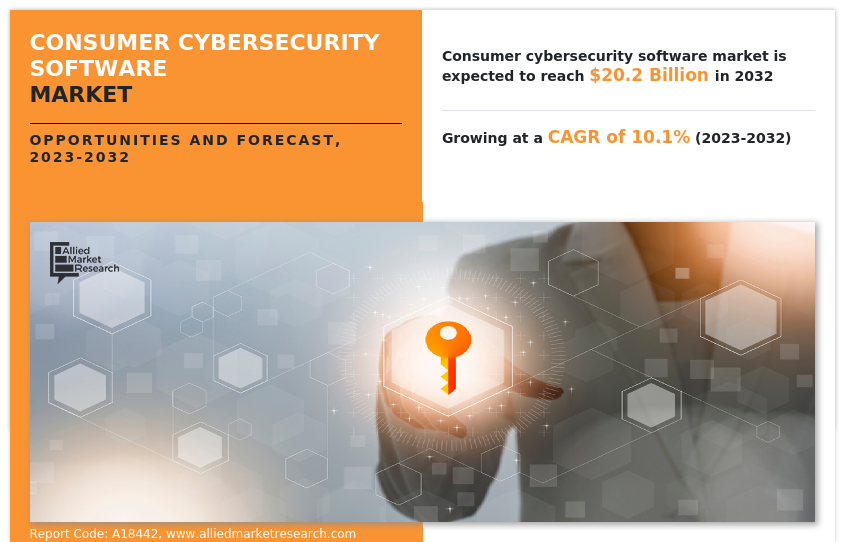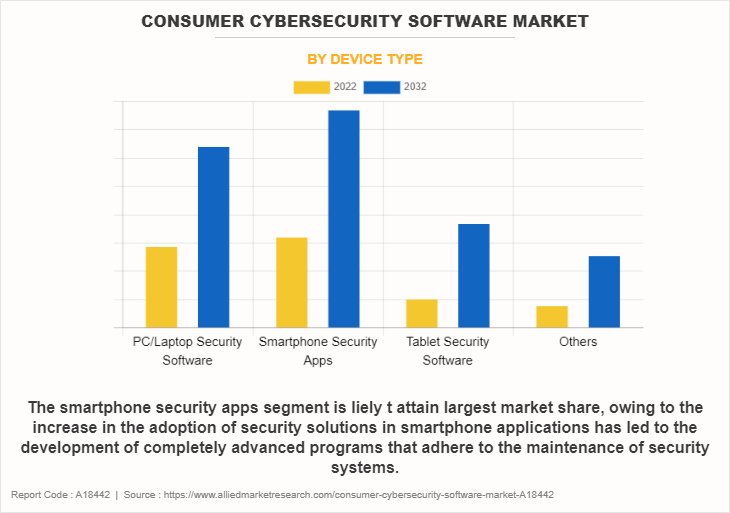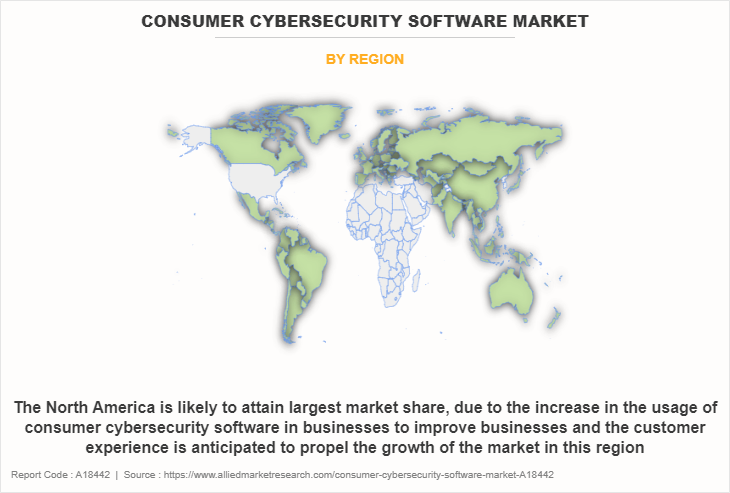Consumer Cybersecurity Software Market Insights: 2032
The global consumer cybersecurity software market size was valued at $7.8 billion in 2022, and is projected to reach $20.2 billion by 2032, growing at a CAGR of 10.1% from 2023 to 2032.
Consumer cybersecurity refers to the standard internet security packages or application tools consisting of anti-malware, anti-spam, and a personal firewall. A consumer has only a few endpoints to manage such as a computer, a smartphone, and one or two other devices on the network, which further drives the global market growth among individuals. However, an associations has various devices that should be safeguarded, such as various computers and PCs to servers, printers, and routers. As a result, organizations for the most part require more refined network protection services.

In addition, the integration of cutting edge innovations like artificial intelligence, ML, and distributed computing can possibly create a few advantages for organizations and customers, including identifying and answering arising issues all the more efficiently. A cybersecurity service can help improve efficiency and productivity for businesses and reduce costs. Moreover, it can provide enhanced security solutions and a better user experience for end users. In addition, cybersecurity strategies provide flexibility and scalability to adapt to evolving threat landscapes and changing business requirements. Such factors are anticipated to provide lucrative opportunities for the market growth during the forecast period.
Factors such as development in digitalization, increasing need for smart software frameworks, and expansion in reception of cutting-edge technologies positively influence the development of the market. In addition, rise in adoption of IoT devices, advancements in AI technology, and growth in demand for automation are expected to fuel the growth of the market during the forecast period. Furthermore, the expansion of cybersecurity applications in various industries is expected to provide lucrative growth opportunities for the market in the upcoming years.
Moreover, development of edge computing technology to enable real-time processing of data and reduce latency and adoption of cloud computing to enable scalability, flexibility, and cost-effectiveness of cybersecurity systems propels the global market growth. However, data privacy & security concerns and lack of standardization in data formats, communication protocols, and networks are expected to hamper the market growth.
The report focuses on growth prospects, restraints, and trends of the consumer cybersecurity software market analysis. The study provides Porter five forces analysis to understand the impact of various factors, such as bargaining power of suppliers, competitive intensity of competitors, threat of new entrants, threat of substitutes, and bargaining power of buyers, on the consumer cybersecurity software market.
Top Impacting Factors
Rise in Number of Sophisticated Cyberattacks
Consumer cybersecurity software industry has become increasingly integrated into various organizations, owing to increase in fraud, cyberattacks, and theft activities. Furthermore, adoption of consumer cybersecurity software in organizations helps them improve awareness, strengthen know your employee (KYE) through technological intervention, and prevent monitoring & surveillance of transactions.
According to Identity Theft and Credit Card Fraud Statistics published in November 2023, bank fraud relating to debit cards, and electronic funds transfers grew by nearly 12% in 2022 as compared to 2021, owing to which many financial institutions have started adopting consumer cybersecurity software solutions in large numbers. As a result, the adoption of consumer cybersecurity software solutions in various institutions drives the growth of the market. Furthermore, the market witnessed a significant upturn, owing to rise in demand for security services globally and the escalating use of digital services in several sectors such as healthcare and manufacturing, post the COVID-19 pandemic, thus driving the market growth.
High Cost of Implementation
High cost associated with consumer cybersecurity software industry hinders the market growth globally. Enterprises, especially small and medium-sized organizations (SMEs), often face financial burdens when contemplating investment in such solutions. Increase in cost is caused by various factors, including charges for software licensing, hardware prerequisites, and ongoing subscriptions for threat feeds, as well as the expenditure involved in recruiting or training competent professionals to effectively manage and utilize these solutions.
Furthermore, there may be hidden costs linked to system integration and customization to cater to the distinct requirements of diverse organizations. This financial barrier has the potential to hinder the adoption of consumer cybersecurity software solutions among organizations with limited resources.
Favorable Government Initiatives and Investments to Strengthen Security Infrastructure
The supportive government policies and increasing investment by public and private authorities in security standards are positively impacting on the market growth. Several regional governments are making strategic investments in expanding security operations. In the digitalized age, government authorities all around the world are perceiving the importance of network safety and information security and integrating proactive measures to safeguard organizations and end users from digital issues.
Further, government policies are undertaking increased initiatives to embrace advanced technology, with plans for integrating new digital security solutions. For instance, in July 2020, the National Security Agency and the Cyber Security and Infrastructure Security Agency unveiled an advisory for critical infrastructure, operational technology, and control systems assets. This advisory solution further expands the awareness with network protection threats among end users, further develops administration execution, and maintain the security guidelines in organizations. Therefore, consumer cybersecurity software gained wider traction among end-users, which in turn, is expected to contribute to robust market growth.
Segment Review
The consumer cybersecurity software market is segmented on the basis of offering, deployment mode, device type, and region. By offering, the market is segmented into application security, network security, identity theft protection, infrastructure protection software, password management software, and others. On the basis of deployment mode, the market is segmented into on-premise and cloud. On the basis of device type, the market is segmented into PC/laptop security software, smartphone security apps, tablet security software, and others. Region-wise, it is analyzed across North America, Europe, Asia-Pacific, Latin America, and MEA.

On the basis of device type, the smartphone security apps segment dominated the consumer cybersecurity software market share in 2022 and, is expected to maintain its dominance during the forecast period, due to rise in demand for security solutions in smartphones, which is further expected to move the overall market improvement. However, the tablet security software segment is expected to exhibit the highest growth during the forecast period, owing to increase in the integration of tablet security software among individuals.

By region, North America dominated the market share in 2022 for the consumer cybersecurity software market. The presence of technological players like Cisco Systems, Inc. Fortinet, and others are insistently influencing the advancement of the consumer cybersecurity software market. However, Asia-Pacific is expected to exhibit the highest growth during the forecast period. This is attributed to the expansion of advanced technologies such as IoT, cloud computing, and others, which further contribute to the growth of consumer cybersecurity software market forecast period.
Competition Analysis:
Competitive analysis and profiles of the major players in the global consumer cybersecurity market include AVG Technologies, CyberArk Software Ltd., Fortinet, Cisco Systems Inc., IBM Corporation, Juniper Networks, Inc., Microsoft Corporation, Sophos Ltd., Check Point Software Technologies, and McAfee. These major players have adopted various key development strategies such as business expansion, new product launches, and partnerships, which help to drive the growth of the consumer cybersecurity software market growth globally.
Recent Product Launches in the Consumer Cybersecurity Software Market:
In June 2020, Unistal launched Protegent endpoint security software. The endpoint security is developed to provide cyber security services for network endpoints. Protegent endpoint security inculcates encryption features for securing the gadgets accessing enterprise networks. Thus, it will assist in controlling any risky activities with proficient monitoring.
Market Landscape and Trends
The COVID-19 prompted every company and business to shift business operations toward a remote work environment. As a result, companies began implementing their bring your own device (BYOD) programs or enterprise-owned equipment. This led to more exposure to cyber-attacks. It further caused increase in the demand for security services due to lockdown measures and transport restrictions imposed by national authorities, while enabling security providers to deliver crucial services. These measures directly impacted on the economy of the IT sector, with the partial or complete shutdown of businesses, particularly international services.
Key Benefits for Stakeholders
This report provides a quantitative analysis of the market segments, current trends, estimations, and dynamics of the consumer cybersecurity software market forecast from 2022 to 2032 to identify the prevailing market opportunities.
Market research is offered along with information related to key drivers, restraints, and opportunities of consumer cybersecurity software market outlook.
Porter's five forces analysis highlights the potency of buyers and suppliers to enable stakeholders to make profit-oriented business decisions and strengthen their supplier-buyer network.
In-depth analysis of the consumer cybersecurity software market segmentation assists in determining the prevailing consumer cybersecurity software market opportunity.
Major countries in each region are mapped according to their revenue contribution to the global market.
Market player positioning facilitates benchmarking and provides a clear understanding of the present position of the market players.
The report includes an analysis of the regional as well as global consumer cybersecurity software market trends, key players, market segments, application areas, and market growth strategies.
Consumer Cybersecurity Software Market Report Highlights
| Aspects | Details |
| Market Size By 2032 | USD 20.2 billion |
| Growth Rate | CAGR of 10.1% |
| Forecast period | 2022 - 2032 |
| Report Pages | 350 |
| By Offering |
|
| By Deployment Mode |
|
| By Device Type |
|
| By Region |
|
| Key Market Players | Sophos Group, Juniper Netwokrs, CyberArk Software Ltd, Check Point Software, AVG Technologies., Fortinet, Cisco Systems Inc., McAfee, IBM Corporation, Microsoft Corporation |
Analyst Review
As the consumer cybersecurity software market continues to evolve, CXOs are evaluating the opportunities and challenges regarding this emerging technology. Businesses acknowledge the significance of protecting confidential data transmitted over several communication channels, especially in industries such as banking and finance, healthcare, and government. Businesses are considering the benefits that consumer cybersecurity software solutions can offer, including the capability to provide an effective means to safeguard personal data, preserve legal compliance, and decrease the potential of data breaches and unauthorized access. In addition, implementing effective consumer cybersecurity software solutions help businesses to maintain the privacy and authenticity of data, safeguarding their enterprise reputation and avoiding potential legal and financial consequences. Such factors are expected to provide lucrative opportunities for the market growth during the forecast period.
Furthermore, consumer cybersecurity software can enable essential risk management measures. By protecting the data and attachments, organizations can minimize the risk of data loss, unauthorized access, and interception. However, businesses also recognize the challenges associated with consumer cybersecurity software solutions. One potential risk is the complexity and usability challenges. This type of software is complicated to deploy and use and may require technical knowledge and additional processes to encrypt and decrypt data, which can make it challenging for organizations to enhance their product offerings in security services. In addition, consumer cybersecurity software solutions require significant investment in security infrastructure and technological expenses, which can be a major restraint for the global market.
Furthermore, rise in concerns regarding interoperability issues is expected to limit the global market growth. There could be incompatibilities between the regulatory standards and protocols used by various cybersecurity solutions, which further hinders the growth of the global consumer cybersecurity software market. Businesses must integrate software or applications by specific standards and protocols. By addressing these challenges, businesses can unlock the full potential of consumer cybersecurity software solutions to transform their security operations, create value, and gain a competitive advantage in their industry. For instance, in March 2021, ActZero raised $40 million funding for making cybersecurity accessible and scalable to small and mid-sized businesses by complementing managed detection and response services with artificial intelligence (AI).
Factors such as development in digitalization, increasing need for smart software frameworks, and expansion in reception of cutting-edge technologies positively influence the development of the market. In addition, rise in adoption of IoT devices, advancements in AI technology, and growth in demand for automation are expected to fuel the growth of the market during the forecast period.
Consumer cybersecurity applications play a crucial role in safeguarding individuals against a myriad of online threats in an increasingly digital world. Antivirus software remains a fundamental tool, continuously evolving to detect and neutralize malware, ransomware, and other malicious entities.
North America is the largest regional market for Consumer Cybersecurity Software.
$20,206.86 million is the estimated industry size of Consumer Cybersecurity Software
AVG Technologies, CyberArk Software Ltd., Fortinet, Cisco Systems Inc., IBM Corporation, Juniper Networks, Inc., Microsoft Corporation, Sophos Ltd., Check Point Software Technologies, and McAfee. are the top companies to hold the market share in Consumer Cybersecurity Software
Loading Table Of Content...
Loading Research Methodology...



